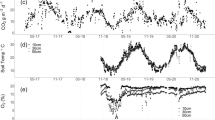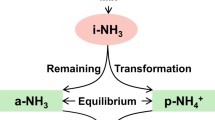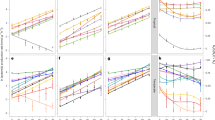Abstract
Ammonia has an important role in atmospheric chemistry and the soil nitrogen cycle, and it has long been suggested that terrestrial ecosystems may be important sources and sinks for atmospheric ammonia in both gaseous and particulate form1–4. But there is relatively little information on the average atmospheric concentrations of NH3 gas and particulate NH+4 and their fluxes to and from ecosystems. Furthermore, much existing data are unreliable because of difficulties in separating gaseous NH3 from particulate NH+4 (refs 1, 5). We have used a new method5,6 which overcomes these difficulties and have made continuous measurements for a 1-yr period at a rural location in Massachusetts. From these data and from measurements of the rate of deposition of ammonium on plastic and natural leaves, we conclude that particulate NH+4 can be a significant nitrogen source for ecosystems, especially pine forests. In contrast, gaseous NH3 is probably of little importance as its concentration is very low.
This is a preview of subscription content, access via your institution
Access options
Subscribe to this journal
Receive 51 print issues and online access
$199.00 per year
only $3.90 per issue
Buy this article
- Purchase on Springer Link
- Instant access to full article PDF
Prices may be subject to local taxes which are calculated during checkout
Similar content being viewed by others
References
National Research Council, Subcommittee on Ammonia, Ammonia 99–176 (University Park Press, Baltimore, 1979).
Farquhar, G. D., Firth, P. M., Wetselaar, R. & Weir, B. Plant Physiol. 66, 710–714 (1980).
Lemon, E. & Van Houtte, R. Agron. J. 72, 876–883 (1980).
Lenhard, U. & Gravenhorst, G. Tellus 32, 48–55 (1980).
Ferm, M. Atmos. Envir. 13, 1385–1393 (1979).
Bos, R. J. Air Pollut. Control Ass. 30, 1222–1224 (1980).
Lau, N. C. & Charlson, R. J. Atmos. Envir. 11, 475–478 (1978).
Tjepkema, J. D. Can. J. Bot. 57, 11–16 (1979).
Likens, G. E., Bormann, F. H., Pierce, R. S., Eaton, J. S. & Johnson, N. M. Biogeochemistry of a Forested Ecosystem, 66–68 (Springer, New York, 1977).
Mayer, R. & Ulrich, B. Atmos. Envir. 12, 375–377 (1978).
Lindberg, S. E., Harriss, R. C., Turner, R. R., Shriner, D. S. & Huff, D. D. Mechanisms and Rates of Atmospheric Deposition of Selected Trace Elements and Sulphate to a Deciduous Forest Watershed (Environmental Science Publ. No. 1299, Oak Ridge National Laboratory (1979)).
Miller, H. G. & Miller, J. D. Proc. Int. Conf. Ecological Impact of Acid Rain, Sandefjurd (SNSF, Oslo, in the press).
Schlesinger, W. H. & Hasey, M. M. Am. Midl. Nat. 103, 114–122 (1980).
Gorham, E., Vitousek, P. M. & Reiners, W. A. A. Rev. Ecol. Syst. 10, 53–84 (1979).
Author information
Authors and Affiliations
Rights and permissions
About this article
Cite this article
Tjepkema, J., Cartica, R. & Hemond, H. Atmospheric concentration of ammonia in Massachusetts and deposition on vegetation. Nature 294, 445–446 (1981). https://doi.org/10.1038/294445a0
Received:
Accepted:
Issue Date:
DOI: https://doi.org/10.1038/294445a0
This article is cited by
-
Ammonia measurements at Niwot Ridge, Colorado and point arena, California using the tungsten oxide denuder tube technique
Journal of Atmospheric Chemistry (1988)
-
Atmospheric aerosols and gases in rural Nova Scotia and their dependence on air flow
Water, Air, and Soil Pollution (1987)
-
The effect of airborne sulphur and nitrogen deposition on aquatic and terrestrial heathland vegetation
Experientia (1986)
-
Dry deposition of nitrate to a deciduous forest
Biogeochemistry (1986)
-
Accession and cycling of elements in a coastal stand ofPinus radiata D. Don in New Zealand
Plant and Soil (1985)
Comments
By submitting a comment you agree to abide by our Terms and Community Guidelines. If you find something abusive or that does not comply with our terms or guidelines please flag it as inappropriate.



